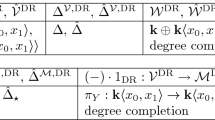Abstract
This paper gives a new and direct construction of the multi-prime big de Rham–Witt complex, which is defined for every commutative and unital ring; the original construction by Madsen and myself relied on the adjoint functor theorem and accordingly was very indirect. The construction given here also corrects the 2-torsion which was not quite correct in the original version. The new construction is based on the theory of modules and derivations over a λ-ring which is developed first. The main result in this first part of the paper is that the universal derivation of a λ-ring is given by the universal derivation of the underlying ring together with an additional structure depending directly on the λ-ring structure in question. In the case of the ring of big Witt vectors, this additional structure gives rise to divided Frobenius operators on the module of Kähler differentials. It is the existence of these divided Frobenius operators that makes the new construction of the big de Rham–Witt complex possible. It is further shown that the big de Rham–Witt complex behaves well with respect to étale maps, and finally, the big de Rham–Witt complex of the ring of integers is explicitly evaluated.
Similar content being viewed by others
References
Atiyah M.F., Tall D.O.: Group representations, λ-rings and the J-homomorphism. Topology, 8, 253–297 (1969)
Beck, J. M., Triples, algebras and cohomology. Repr. Theory Appl. Categ., 2 (2003), 1–59.
Berthelot, P., Grothendieck, A. & Illusie, L., Théorie des intersections et théorème de Riemann–Roch, in Séminaire de Géometrie Algébrique du Bois-Marie 1966–1967 (SGA 6), Lecture Notes in Math., 225. Springer, New York, 1971.
Bökstedt, M., Hsiang, W. C. & Madsen, I., The cyclotomic trace and algebraic K-theory of spaces. Invent. Math., 111 (1993), 465–539.
Borger, J., Lambda-rings and the field with one element. Preprint, 2009. arXiv:0906.3146 [math.NT].
Borger, J., The basic geometry of Witt vectors, I: The affine case. Algebra Number Theory, 5 (2011), 231–285.
Borger, J. & Wieland, B., Plethystic algebra. Adv. Math., 194 (2005), 246–283.
Cartier, P., Groupes formels associés aux anneaux de Witt généralisés. C. R. Acad. Sci. Paris Sér. A-B, 265 (1967), A49–A52.
Costeanu V., On the 2-typical de Rham–Witt complex. Doc. Math., 13 (2008), 413–452.
Geisser, T. & Hesselholt, L., The de Rham–Witt complex and p-adic vanishing cycles. J. Amer. Math. Soc., 19 (2006), 1–36.
Grothendieck, A., La théorie des classes de Chern. Bull. Soc. Math. France, 86 (1958), 137–154.
Hazewinkel, M., Formal Groups and Applications. Pure and Applied Mathematics, 78. Academic Press, New York–London, 1978.
Hesselholt, L., On the p-typical curves in Quillen’s K-theory. Acta Math., 177 (1996), 1–53.
Hesselholt, L., Algebraic K-theory and trace invariants, in Proceedings of the International Congress of Mathematicians, Vol. II (Beijing, 2002), pp. 415–425. Higher Ed., Beijing, 2002.
Hesselholt, L. & Madsen, I., On the K-theory of nilpotent endomorphisms, in Homotopy Methods in Algebraic Topology (Boulder, CO, 1999), Contemp. Math., 271, pp. 127–140. Amer. Math. Soc., Providence, RI, 2001.
Hesselholt, L. & Madsen, I., On the K-theory of local fields. Ann. of Math., 158 (2003), 1–113.
Hesselholt, L. & Madsen, I., On the de Rham–Witt complex in mixed characteristic. Ann. Sci. École Norm. Sup., 37 (2004), 1–43.
Hiller, H. L., λ-rings and algebraic K-theory. J. Pure Appl. Algebra, 20 (1981), 241–266.
Illusie, L., Complexe de de Rham–Witt et cohomologie cristalline. Ann. Sci. École Norm. Sup., 12 (1979), 501–661.
van der Kallen, W., Descent for the K-theory of polynomial rings. Math. Z., 191 (1986), 405–415.
Knutson, D., λ-Rings and the Representation Theory of the Symmetric Group. Lecture Notes in Math., 308. Springer, Berlin–New York, 1973.
Kratzer, C., λ-structure en K-théorie algébrique. Comment. Math. Helv., 55 (1980), 233–254.
Langer, A. & Zink, T., de Rham–Witt cohomology for a proper and smooth morphism. J. Inst. Math. Jussieu, 3 (2004), 231–314.
MacLane, S., Categories for the Working Mathematician. Graduate Texts in Mathematics, 5. Springer, Berlin–New York, 1971.
Mumford, D., Lectures on Curves on an Algebraic Surface. Annals of Mathematics Studies, 59. Princeton Univ. Press, Princeton, NJ, 1966.
Stienstra, J., Cartier–Dieudonné theory for Chow groups. J. Reine Angew. Math., 355 (1985), 1–66.
Teichmüller, O., Über die Struktur diskret bewerteter perfekte Körper. Nachr. Ges. Wiss. Göttingen, 1 (1936), 151–161.
Wilkerson, C., Lambda-rings, binomial domains, and vector bundles over CP(∞). Comm. Algebra, 10 (1982), 311–328.
Witt, E., Zyklische Körper und Algebren der Charakteristik p vom Grad p n. Struktur diskret bewerteter perfekter Körper mit vollkommenem Restklassenkörper der Charakteristik p. J. Reine Angew. Math., 176 (1936), 126–140.
Author information
Authors and Affiliations
Corresponding author
Additional information
Generous assistance from DNRF Niels Bohr Professorship, JSPS Grant-in-Aid 23340016, and CMI Senior Scholarship is gratefully acknowledged.
Rights and permissions
About this article
Cite this article
Hesselholt, L. The big de Rham–Witt complex. Acta Math 214, 135–207 (2015). https://doi.org/10.1007/s11511-015-0124-y
Received:
Revised:
Published:
Issue Date:
DOI: https://doi.org/10.1007/s11511-015-0124-y



